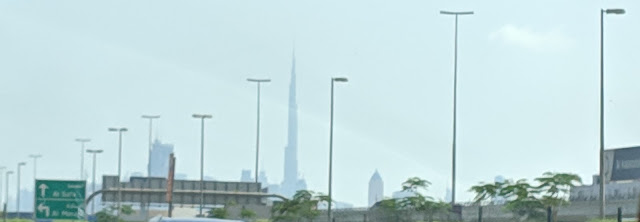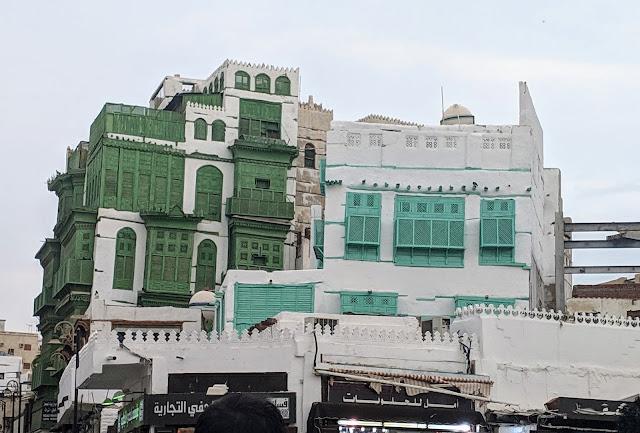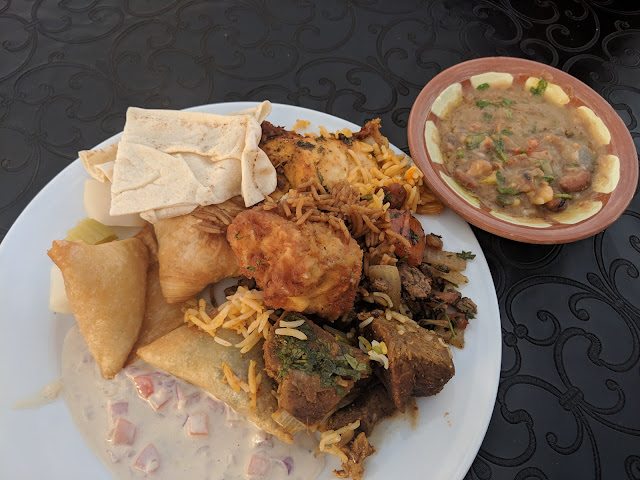Currently the tallest building in the world resides in Dubai. The Burj Khalifa soars to 2,722 feet and has 163 floors that people can occupy before being topped by the metal spire. No visit to Dubai is complete without a visit to it and, preferably, to the top of it.
 Started in 2004 and completed in 2009, the tower was officially opened in 2010. It is a mix-use building, including retail, residential, and commercial offices. At the 122nd floor is Atmosphere, the highest restaurant in the world.
Started in 2004 and completed in 2009, the tower was officially opened in 2010. It is a mix-use building, including retail, residential, and commercial offices. At the 122nd floor is Atmosphere, the highest restaurant in the world.What I found fascinating about the tower is how your perception of its height differs depending on your vantage point. Proximity of other buildings and distance can really distort your perception of its height. When we first arrived and drove by it, the other buildings were close to us and so the building didn't seem that tall. But when you were several miles away looking toward downtown, you could clearly see how much higher it soared over every other building in the vicinity.
There are two ways to go up the Burj Khalifa and I will tell you the difference between the two.
The first is what a majority of people do because it is an impulse visit versus being planned well in advance. Most people buy tickets at the entrance or within a few days on the website. This allows you only to go up to the 125th floor with the masses. While the view is still spectacular, wouldn't you prefer to go as high as you can possibly go? To do so requires advance planning.
If you know when you are going to be in Dubai, then it pays to buy the Sky (VIP) ticket to be able to go to the 148th floor. This is the highest point allowed for visitors as the final 12 floors are reserved for corporations.
Book your visit to Burj Khalifa.
The Sky tickets are sold online well in advance for a limited number of tickets. These tickets include a waiting lounge with coffee, personal tour guide and fast tracking through the lines, unlimited time at the 148th floor with refreshments, access to the (crowded) 124th/125th floor observation decks, and VIP (fast track) exit from the tower.
I can't emphasize enough how much more enjoyable this was just by observing everybody else going only to 125. The Sky experience was much more relaxing without having to deal with pushy people and long line waits.
From the outside...
You don't have to go to the top to enjoy the Burj Khalifa. They offer two worthwhile viewing events that are completely free to watch from the ground level.
The fountain show runs from 6-11 pm at the top and bottom of every half hour. The fountains are by the same company that did the Las Vegas Bellagio, but this set is even larger. Every show is set to a different song, so you can watch something different each time. Above you can see the one done to the Mission Impossible theme and then again from the viewpoint of the 148th floor above. The Mission Impossible was my favorite because I love that music and it's appropriate because MI:Ghost Protocol was actually filmed here. There's an action scene at the Burj Khalifa.
Don't leave after the fountain show because on the 15 and 45 minute marks there are light shows on the tower itself. Below are snippets from two. Note that for copyright purposes, I've silenced the sound.
The Burj Khalifa is attached to the Mall of Dubai, a massive shopping structure filled with almost every retailer you can think of from the U.S., U.K., and more. There are also dozens of restaurants from fast food to fine dining.
The Burj Khalifa is a must item on the Dubai to-do list. Be sure to schedule an evening for it on your itinerary.
Book your visit to Burj Khalifa.



















